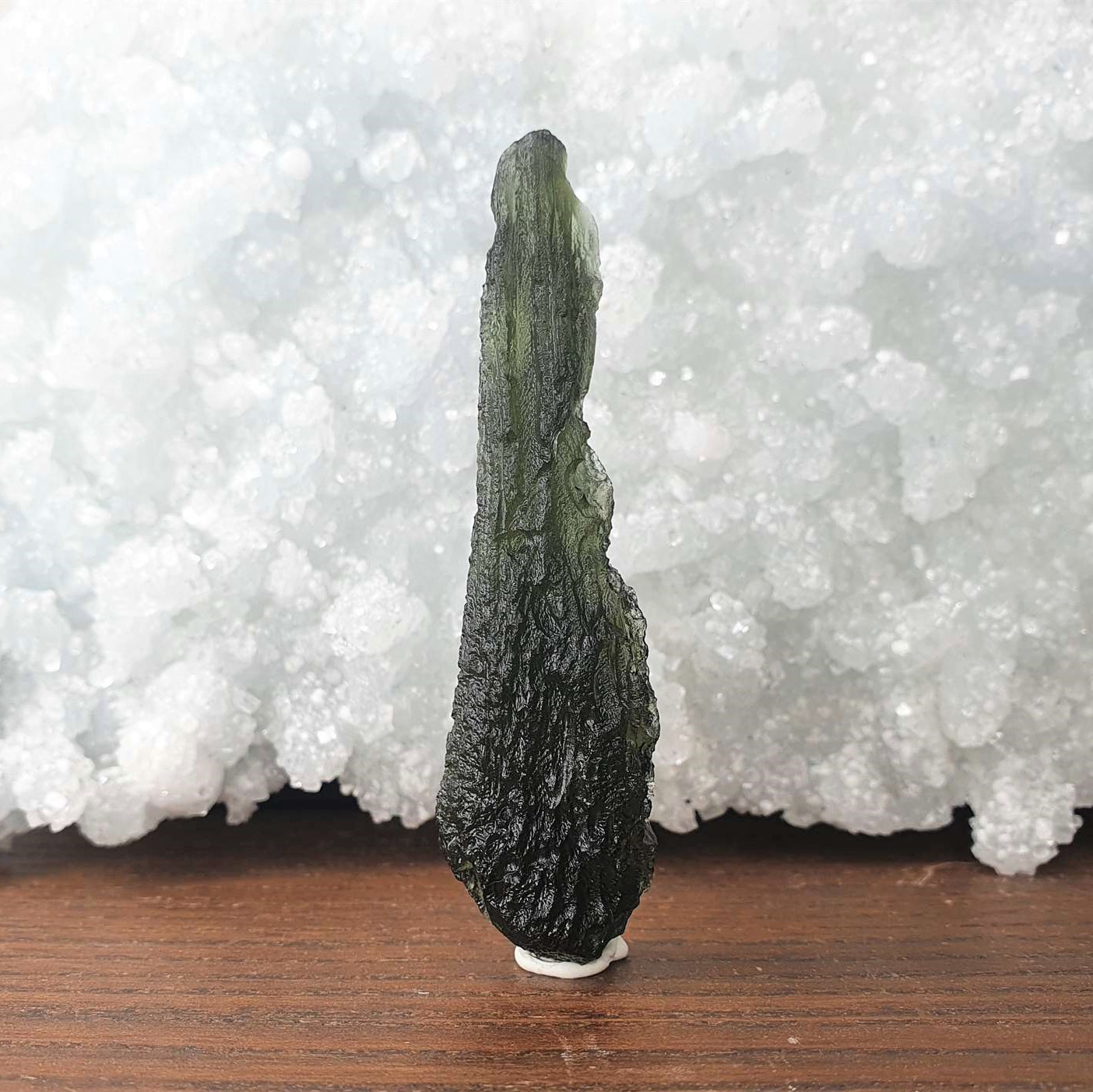There are many different grades of Moldavite that people have developed based on their experience or personal preferences with Moldavite. It can be confusing to know what is being described and what you are actually purchasing.
A Deeper Look into the Grades of Moldavite
The Best and Most Premium Quality Moldavite
The common names for the best Moldavite are Collection Quality, Special Pieces, Investor Grade, Museum Grade (note – the word Museum Grade has been overused and most of what is labelled Museum grade Moldavite on the market is just good quality A-grade Moldavite).
Moldavite at this level usually have a combination of two or more factors which make them more desirable and rare. Moldavite within this category can be rated higher (e.g. a 40 gram perfect Besednice hedgehog or a 100 gram perfect Dumbbell shape), and some which are rated lower (e.g. a perfect condition drop shape or perfectly symmetrical Moldavite). The more rare the Moldavite, the higher the price will be.
The main factors are:
- Condition of the Moldavite: Very minimal to no damage, or with chips and nicks
- A primary shape(drop, disk, ellipsoid, sphere and dumbbell), or other beautiful or symmetrical shape – (note: most collection quality Moldavite are usually a pleasing shape to the eye)
- Larger size/weight – note: collection quality Moldavite vary in size from small 2 grams to large 100+ gram stones
- Beautiful sculpting – note: sculpting of some Moldavite can make them collection quality such as with hedgehogs but it is not required)
- A rare locality – note: all localities of Moldavite will have collection quality pieces. Just having an undamaged Moldavite from a rare locality does not make it a collection quality piece
- Rare features – such as an angel chime are an optional bonus but not necessary.
There are many other factors which impact the grade such as sculpting and location. Read more about it here www.stonesoftransformation.com.au/blog/guide-for-pricing-moldavite-15-factors-to-know



Top Grade Moldavite
The common names for top grade Moldavite are Collection Grade or Museum Grade (see Myth 3 below about Museum grade here www.stonesoftransformation.com.au/blog/busting-some-myths-of-moldavite/). However, we often see these names being misused to describe good quality Moldavite. Moldavite at this level typically means that they are special stones such as primary shapes (www.stonesoftransformation.com.au/blog/guide-to-the-shapes-of-moldavite/), extra large sizes, or a combination of rare characteristics (e.g. locality, sculpting, length).



Good Quality Moldavite
The common names for good quality Moldavite are A Grade, AA or AAA Grade, Premium Grade, Superior Grade, or Museum Grade (see Myth 3 below about Museum grade below). Moldavite at this level typically means that there is little to no visible damage (e.g. chips, nicks, abrasion) on the Moldavite. It can sometimes refer to larger stones above 10 grams but this is often not true. Good quality Moldavite can vary from a nice undamaged 50+ gram to smaller 1 to 4 gram Moldavite.



Average Quality Moldavite
The common names for average quality Moldavite are B Grade or Regular Grade. These Moldavite stones may have more noticeable or visible damage (e.g. larger or multiple chips or nicks, abrasion) from mining, transport, or millions of years of rain water erosion. The chips and nicks usually show as shiny spots of the Moldavite where the glass (Moldavite is a natural glass) is reflecting the light.



Below Average Quality Moldavite
The common names for below average quality Moldavite are Cutting Grade or Damaged Grade. These Moldavite stones have usually been broken or severely damaged during the mining process and are usually reserved for turning into beautiful faceted or polished jewelry or carvings.
Common Myths
Myth 1 – The lightness or darkness of a Moldavite impacts the grade. Darker Moldavite is a lower grade.
The lightness or darkness has no impact on the grade of Moldavite. Thicker Moldavite stones can of often look darker as less light can pass though the natural glass. Some people think lighter or darker pieces are nicer but that is just their personal taste.
There are many other factors which impact the grade such as sculpting and location. Read more about it here www.stonesoftransformation.com.au/blog/guide-for-pricing-moldavite-15-factors-to-know
Myth 2 – A higher grade Moldavite will mean stronger energy and impact my life more
There is no relationship between the energy and grade of Moldavite. The grading system is used to describe factors such as damage and rarity. All Moldavite has the same energy whether it is a perfect collection piece or has been damaged during mining, or is an extra large 70 gram or just a small 1 gram Moldavite.
Myth 3 – Museum quality/grade Moldavite is the best and good enough to be in a museum
Museum grade is thrown around with Moldavite in a very loose fashion and the word has been abused in the Moldavite market. It can refer to a range of qualities from being in perfect condition, great surface sculpting and/or shape. The term ‘museum grade’ implies that it would be good enough to be seen in a museum and almost all of the Moldavite that has been labelled as museum grade is usually A grade Moldavite in good condition with minimal damage.
Want more useful information?
See the guides:
Guide to Genuine and Fake Moldavite: www.stonesoftransformation.com.au/blog/fake-moldavite-guide/
The Best Guide on Spotting and Avoiding Fake Moldavite: www.stonesoftransformation.com.au/the-best-guide-on-spotting-and-avoiding-fake-moldavite/
Shapes of Moldavite: www.stonesoftransformation.com.au/blog/guide-to-the-shapes-of-moldavite/
Busting myths of Moldavite: www.stonesoftransformation.com.au/busting-some-myths-of-moldavite/
Other useful guides and blog posts: www.stonesoftransformation.com.au/blog/list-of-useful-posts/
Follow our Facebook page for updates on great information: www.facebook.com/StonesofTransformationMoldaviteStore
Customer reviews: www.stonesoftransformation.com.au/reviews/
Shop and sale page: www.stonesoftransformation.com.au/shop/
With love and blessings.

